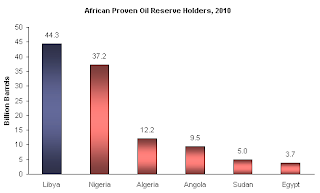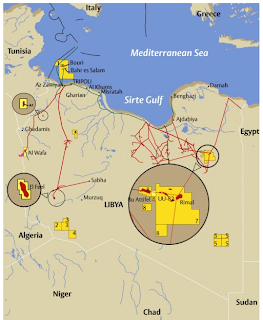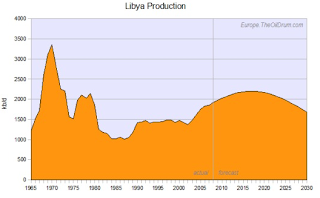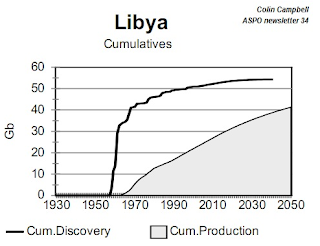
 Recent unrest in Libya has led to unrest in the world’s oil markets. In this posting, I’ll take a brief look at Libya’s contribution to the world’s oil picture.
Recent unrest in Libya has led to unrest in the world’s oil markets. In this posting, I’ll take a brief look at Libya’s contribution to the world’s oil picture.Libya is one 12 current members of OPEC, joining the Organization in 1962, two years after OPEC was founded in 1960 by Iran, Iraq, Kuwait, Saudi Arabia and Venezuela. Libya played a pivotal role in the world’s 1973 oil crisis and, for nearly 3 decades, played the role of a rather belligerent producer. According to OPEC, revenues from Libya’s oil sector contribute about 95 percent of its export earnings and about 25 percent of its gross domestic product. As well, because Libya has a relatively small population of 6.4 million people and a relatively high GDP of $67.2 billion, it has one of the highest per capita GDPs in Africa at $10,479 although the wealth is distributed far from evenly with approximately one-third of Libyans living below the national poverty line.
Here are two pie charts showing OPEC’s share of the world’s crude oil reserves in 2009 and a country-by-country breakdown of oil reserves in each of the 12 OPEC nations:
Within the OPEC family, Libya has the seventh highest reserves at 4.4 percent of the total; well below Saudi Arabia at 264.6 billion barrels and Venezuela at 211.2 billion barrels.
According to the Energy Information Administration (EIA), Libya has total proven reserves of 44 billion barrels of oil as of January 2010, the largest proven oil reserves in Africa. Here is a graph comparing proven oil reserves for major oil producing nations in Africa:
Notice how, other than Nigeria, Libya’s oil reserves total more than the other four major African oil producing nations.
Here is a map showing the location of Libya’s oil fields and the country’s major pipeline infrastructure:
Exploration for oil began in 1956 when the first exploration concessions were granted to foreign-owned corporations. Oil was discovered in Libya in 1959 and oil exports began in 1961. Rapid development of the country’s oil fields resulted in oil production exceeding 3 million barrels of oil per day (BOPD) by 1969. Fortunately for Libya, their crude is relatively light and sweet with gravities ranging from 26 to 43 degrees API. In 1970, the Libyan government nationalized the country’s oil industry and by 1972, production had dropped to 2 million BOPD. By 1973, Libya’s support for the oil embargo to the United States resulted in further production drop to 1.5 million BOPD and to just over 1 million BOPD by 1987, the year that Pan Am Flight 103 exploded over Lockerbie. Despite sanctions imposed by the United Nations in 1992, oil production rose to 1.4 million BOPD where it remained until the turn of the millenium. Sanctions were lifted in 2004 and cooperation with international oil companies led to an increase in production to nearly 1.9 million BOPD. Here is a graph showing Libya’s oil production over the entire history of its oil industry as well as its production forecast to the year 2030; Libya’s oil production is forecast to rise to roughly 2.2 million BOPD over the next decade and then gently decline to just around 1.6 million BOPD in 2030 by which time the country will have produced 35 billion barrels:
Here is a graph showing Iraq’s oil production and consumption for the last 10 years from the EIA. Notice how small Libya’s domestic consumption rate is when compared to its overall production:
In the most recent year for which data is available from OPEC, Libya produced at average of 1.474 million BOPD (its quota) but according to the EIA, the country produced 1.65 million BOPD, 150,000 BOPD below its capacity but well above its official quota.
Here is a graph showing cumulative oil production and cumulative oil discoveries. Note how discoveries rapidly rose during the 1960s and rapidly levelled off from 1990 onward:
By 2003, oil discoveries totalled 52 billion barrels of which 23 billion had already been produced. At the discovery rate of 100 million barrels per year (average for the immediate previous years), Colin Campbell at the Association for the Study of Peak Oil (ASPO) estimated that Libya’s ultimate reserves will reach 55 billion barrels of oil. By 2007, over 27 billion barrels of oil had been produced meaning that the country was at or near its reserve midpoint (think peak oil).
Like other Middle East nations, Libya is experiencing rapid population growth. Libya’s birth rate reached 7.59 births per woman in 1971 and dropped slowly to 2.69 births per woman in 2008. In 1950, Libya was home to 1 million residents; by the turn of the millenium, that number had reached over 5 million and is projected to reach 8 million people by 2025. As the population has risen, so has the country’s domestic oil consumption. On top of the rise in population, per capita consumption has risen by around 2.5 percent per year since 2003 from 14.3 barrels of oil per person per year in 2000 to 17.3 barrels of oil per person per year by 2007. As shown in this chart, per capita oil consumption is projected to rise to around 26 barrels of oil per capita by 2030, equal to today’s per capita consumption level in the United States:
While the per capita rise may seem high, in 2009, Libya was only consuming 280,000 barrels of oil per day and this is projected to rise to just less than 600,000 barrels of oil per day by 2030.
According to the EIA, Libya’s net exports for 2009 were roughly 1.5 million BOPD with the vast majority of oil being exported to Italy (425,000 BOPD), Germany (178,000 BOPD) and France (133,000 BOPD). Here is a pie chart showing the beneficiaries of Libya’s oil exports:
According to the EIA, Italy imported 1.36 million BOPD total in 2009 and Libya contributed the most of any nation by a wide margin supplying Italy with 31 percent of its needs. In the case of Germany, Libya supplies 8 percent of its net oil imports and in the case of France, Libya supplies 7.6 percent of its net oil imports. Libya exported an estimated 80,000 BOPD to the United States in 2009, well off highs of 117,000 BOPD in 2007 because of the economic slowdown and drop in demand.
While Libya is not a huge player in the world’s oil industry compared to giants like Venezuela and Saudi Arabia, the oil they produce is an important component of Italy’s imports in particular and, while the country contributes only 2 percent of the world’s daily oil production, as the point of peak oil is reached and passed, continued production of oil from Libya will remain key to maintaining balance between supply and demand. That said, in the grand scheme of things, freedom of repressed people around the world is far more important than how much it costs us to fill our vehicles with gasoline.
Click HERE to read more of Glen Asher’s columns.
References:
Article viewed at: Oye! Times at www.oyetimes.com
You can publish this article on your website as long as you provide a link back to this page.









Be the first to comment